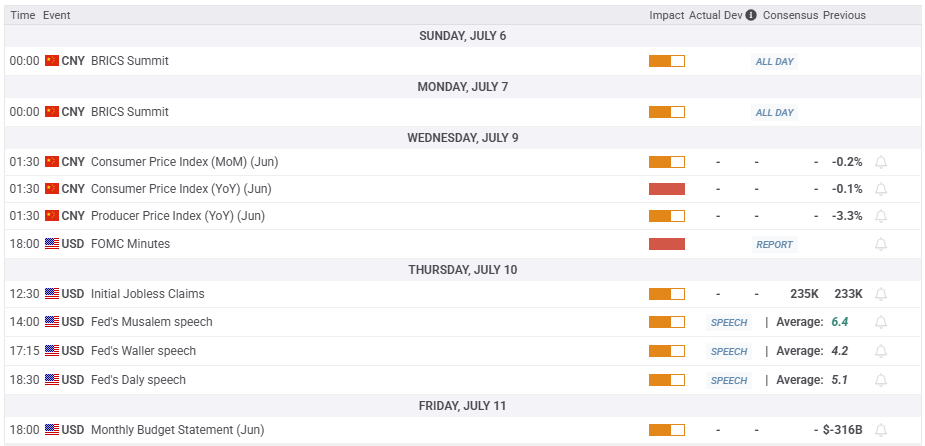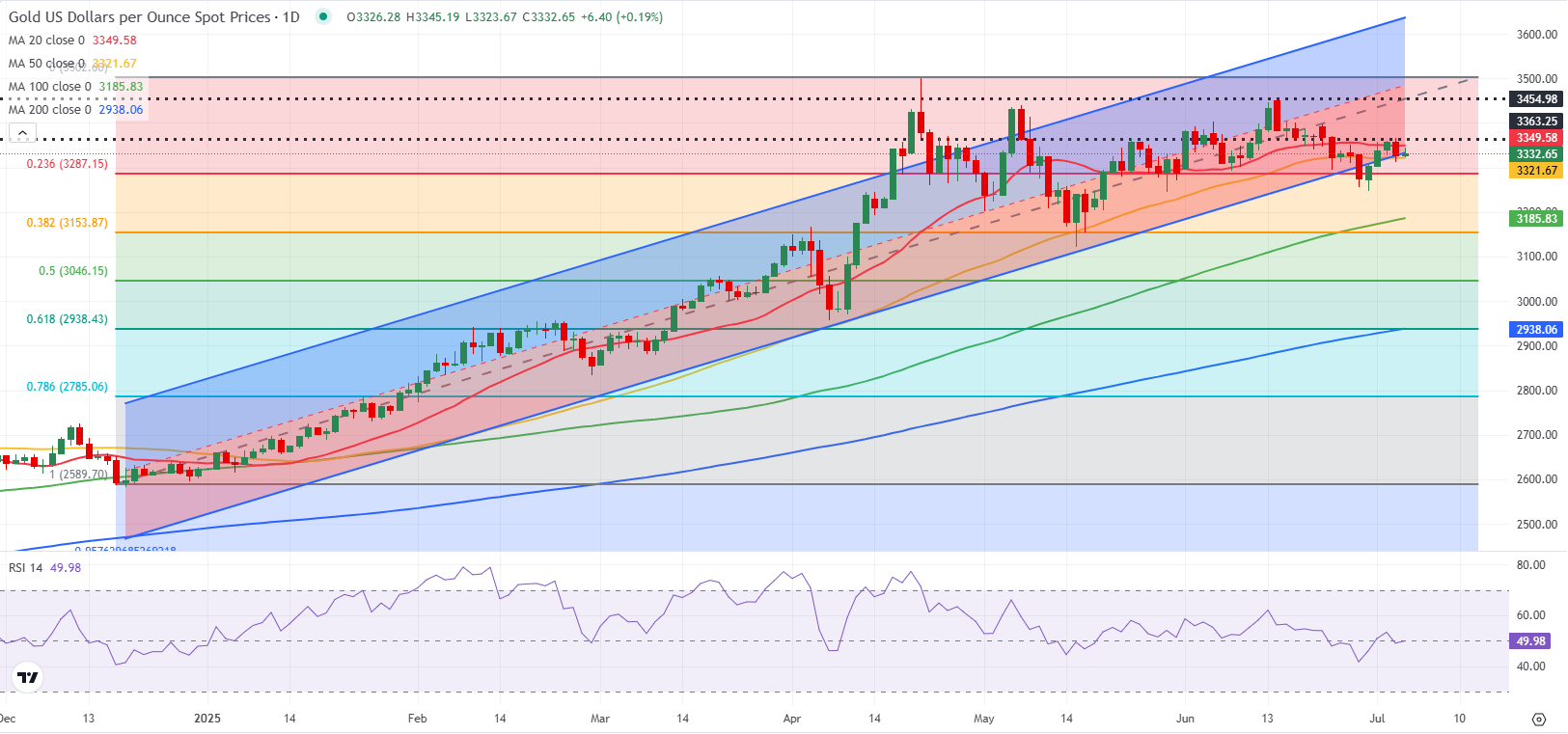- Gold reclaimed $3,300 and broke a two-week losing streak.
- The near-term technical outlook doesn’t yet point to a buildup of bullish momentum.
- Markets will pay close attention to US trade talks.
Gold (XAU/USD) started the week on a firm footing and registered gains for three straight days before losing its momentum once it became clear that the US Federal Reserve (Fed) isn’t likely to cut interest rates soon. In the absence of high-tier macroeconomic data releases, headlines surrounding the US tariff negotiations could drive XAU/USD’s action in the short term.
Gold reclaims $3,300 but lacks strength
The broad-based selling pressure surrounding the US Dollar (USD) helped XAU/USD gain traction on Monday. White House press secretary Karoline Leavitt told reporters that United States (US) President Donald Trump sent a handwritten note to Federal Reserve (Fed) Chairman Jerome Powell, urging him to lower interest rates. She added that Trump believes interest rates should be lowered to about 1%.
Gold continued to stretch higher on Tuesday, possibly by attracting technical buyers after clearing $3,300. Nevertheless, hawkish remarks from Fed Chairman Powell at the European Central Bank’s (ECB) Forum on Central Banking helped the USD shake off the selling pressure and limited XAU/USD’s upside. Powell reiterated that, while the US economy remains solid, they are going to remain patient regarding policy easing and noted that they expect higher inflation readings over the summer.
The data published by Automatic Data Processing showed on Wednesday that employment in the private sector declined by 33,000 in June. This print missed the market expectation for an increase of 95,000 by a wide margin and weighed on the USD. In turn, XAU/USD edged higher and closed the third consecutive day in positive territory.
On Thursday, the US Bureau of Labor Statistics reported that Nonfarm Payrolls (NFP) rose by 147,000 in June, surpassing the market forecast of 110,000. Additionally, the Unemployment Rate declined to 4.1% from 4.2% in May.
The data, which showed the US labor market remains quite resilient, led to a sharp decline in bets for an interest-rate cut in July. The probability of a 25 basis points Fed rate cut later this month dropped to about 5% from nearly 20% ahead of the release of the upbeat labor market data, according to the CME FedWatch Tool.
The USD gathered strength as a result and caused Gold to erase a portion of its weekly gains. With the financial markets in the US remaining closed in observance of the July 4 holiday, Gold entered a consolidation phase on Friday.
Gold investors will keep a close eye on US trade talks
The economic calendar will not offer any high-impact data releases. On Wednesday, the Federal Reserve will publish the minutes of the June policy meeting. At this point, markets are largely convinced that the Fed will stay on hold in July and opt for a rate cut in September. Hence, this publication is unlikely to offer any fresh information that could cause markets to reassess the Fed’s rate outlook.
US President Donald Trump announced that they will start sending letters to trading partners from Friday, July 4, explaining the tariff rates they will face when the 90-day pause ends July 9. In case Trump’s team manages to finalize trade agreements ahead of the deadline, risk flows could dominate the action in financial markets.
This development could also ease fears over an economic downturn in the US. In this scenario, Gold could come under renewed selling pressure. Conversely, markets could turn cautious if they fail to reach a deal and Trump’s tariffs go into effect, especially on major trading partners such as the European Union, Canada and Japan.
Meanwhile, Hamas is reportedly moving closer to accepting a proposed deal for a ceasefire in Gaza. Earlier in the week, US President Trump claimed that Israel is ready to agree to a 60-day ceasefire and use that time to work on a final agreement to end the war. Israeli Prime Minister Benjamin Netanyahu is expected to meet with Trump on July 6 to discuss the war. If markets start the week with news of Israel-Hamas conflict ending, even if temporarily, Gold could turn south with the immediate reaction.

Gold technical analysis
Gold trades near the lower limit of the six-month-old ascending regression channel, currently located at $3,330, and the Relative Strength Index (RSI) indicator on the daily chart moves sideways near 50, reflecting a lack of directional momentum.
In case Gold drops below $3,330 and starts using this level as resistance, $3,285 (Fibonacci 23.6% retracement of the six-month-old uptrend) could be seen as the next support level before $3,185 (100-day Simple Moving Average) and $3,150 (Fibonacci 38.2% retracement).
On the upside, a static resistance level seems to have formed at $3,370 ahead of $3,400 (static level, round level) and $3,455 (static level).

Tariffs FAQs
Tariffs are customs duties levied on certain merchandise imports or a category of products. Tariffs are designed to help local producers and manufacturers be more competitive in the market by providing a price advantage over similar goods that can be imported. Tariffs are widely used as tools of protectionism, along with trade barriers and import quotas.
Although tariffs and taxes both generate government revenue to fund public goods and services, they have several distinctions. Tariffs are prepaid at the port of entry, while taxes are paid at the time of purchase. Taxes are imposed on individual taxpayers and businesses, while tariffs are paid by importers.
There are two schools of thought among economists regarding the usage of tariffs. While some argue that tariffs are necessary to protect domestic industries and address trade imbalances, others see them as a harmful tool that could potentially drive prices higher over the long term and lead to a damaging trade war by encouraging tit-for-tat tariffs.
During the run-up to the presidential election in November 2024, Donald Trump made it clear that he intends to use tariffs to support the US economy and American producers. In 2024, Mexico, China and Canada accounted for 42% of total US imports. In this period, Mexico stood out as the top exporter with $466.6 billion, according to the US Census Bureau. Hence, Trump wants to focus on these three nations when imposing tariffs. He also plans to use the revenue generated through tariffs to lower personal income taxes.
Information on these pages contains forward-looking statements that involve risks and uncertainties. Markets and instruments profiled on this page are for informational purposes only and should not in any way come across as a recommendation to buy or sell in these assets. You should do your own thorough research before making any investment decisions. FXStreet does not in any way guarantee that this information is free from mistakes, errors, or material misstatements. It also does not guarantee that this information is of a timely nature. Investing in Open Markets involves a great deal of risk, including the loss of all or a portion of your investment, as well as emotional distress. All risks, losses and costs associated with investing, including total loss of principal, are your responsibility. The views and opinions expressed in this article are those of the authors and do not necessarily reflect the official policy or position of FXStreet nor its advertisers. The author will not be held responsible for information that is found at the end of links posted on this page.
If not otherwise explicitly mentioned in the body of the article, at the time of writing, the author has no position in any stock mentioned in this article and no business relationship with any company mentioned. The author has not received compensation for writing this article, other than from FXStreet.
FXStreet and the author do not provide personalized recommendations. The author makes no representations as to the accuracy, completeness, or suitability of this information. FXStreet and the author will not be liable for any errors, omissions or any losses, injuries or damages arising from this information and its display or use. Errors and omissions excepted.
The author and FXStreet are not registered investment advisors and nothing in this article is intended to be investment advice.








